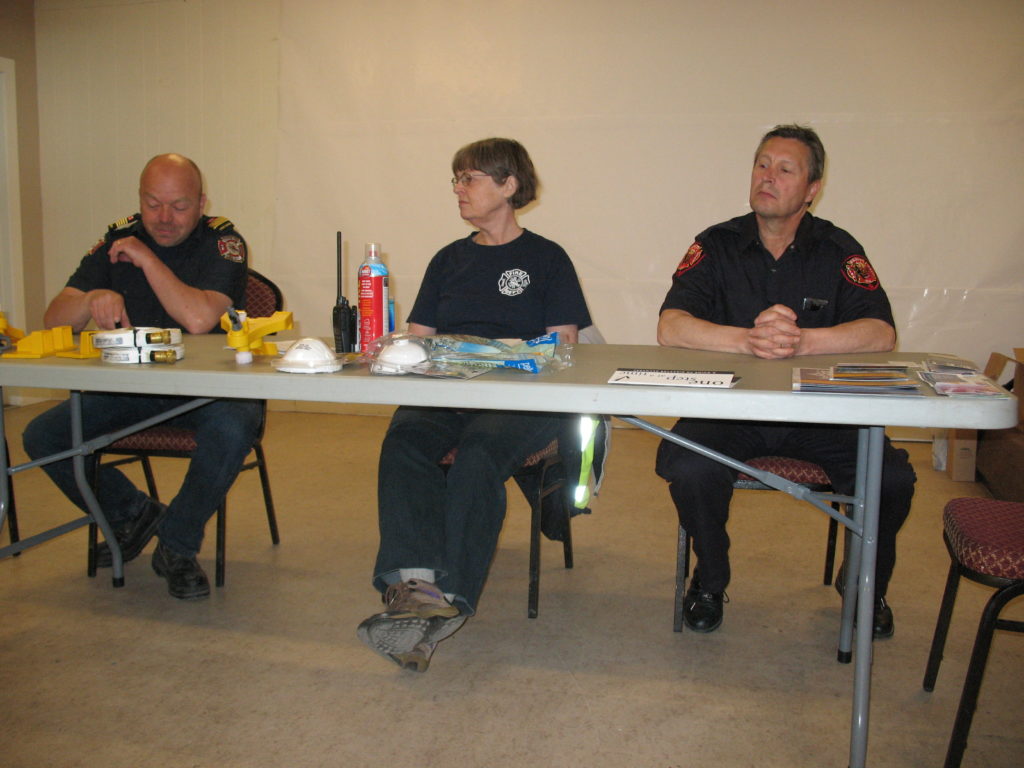
We are becoming increasingly aware that wildfires can be as devious and remorseless as a corrupt politician. Until recent years, their destructive insidious nature existed mostly in the fertile minds of science fiction writers. Now, with the advent of climate change, fire departments even in small communities are striving to alert us to the potential hazards and make us aware of strategies we can employ to protect ourselves.
At a seminar organized by the Hedley Fire Department, Erris Fire Chief Dave Stringfellow told a sobering story of how a crafty fire can take advantage of our mistakes. “A fire department built a new fire hall using hardie board and metal roofing,” he said. “On the exterior, wood was used only for construction of the stairs. When there was a wildfire in the area, embers floated to lumber stored under the stairs, igniting a conflagration that burned down their brand new fire hall.”
Surprisingly, only 20 individuals attended this all important seminar. With many structures in the Similkameen Valley being of considerable age and surrounded by forest or grass, complacency seems particularly ill-founded. Reality does not cease to exist just because we ignore it. I’ve heard that some people forgot about the event and regret having missed it.
In Hedley, we saw last year just how quickly a fire can ravage a building. As has been extensively reported in the media, Trisha Mills and Bill Carmichael scarcely had time to escape when their Hitching Post restaurant caught fire. Serious injuries changed their lives, possibly forever. Ken Hoyle, manager of the Hedley Fire Department said, “If there had been wind that night, a number of Hedley structures would almost certainly have burned.”
Fire departments throughout our province are becoming deeply concerned about the danger wildfires pose for their communities. I understood the preoccupation with interface fires more clearly when Fire Fighter Robin Ford said, “Forty percent of wildfires are started by humans and they can travel rapidly. One fire raced the distance of 6 football fields in one minute. The most common loss of homes is by burning embers, not by a wall of flame. Embers can travel 5 to 15 kilometers. Debris in gutters, dry grass, trash around buildings make it easy for them to ignite a fire that can burn one or more homes.”
Ford advocated for masks in the home to protect against smoke. “Also, a 6 ml tarp over your wood pile or patio is a shield against embers,” she said. “Patio chair cushions ignite easily so it’s best to remove them.” She recommended a sprinkler system available from some fire departments.

Maureen Parsley, Director of Princeton Emergency Support Services said, “It’s wise to plan in advance and do what you can to minimize the risks. It’s important to have a bag ready to go with what you will need in an evacuation.” Her list includes items like medications, clothes, shoes, a rope, toilet paper, a solar blanket, flashlight and batteries, cell phone and an adapter to charge the battery, bottled water, food, and much more.
Certainly in an emergency we don’t want to be frantically dashing around searching for car keys, wallet, eye glasses, dentures, or the lottery ticket on which rests our hopes for the future. We will want enough gas in the tank to get to a safe place.
Many local B.C. fire departments and other agencies offer helpful advice on their website. Because Fort Mac Murray fire fighters experienced one of the most devastating fires on record, their website is also worth a look. In part, it says, “In most instances, we will have only 3 minutes to escape from a burning home. Prepare and practise a fire escape plan. Have a designated meeting place for the family outside the home. Do a fire drill 2 times each year. This should include pressing the smoke alarm button to ensure everyone will recognize the sound in an emergency. Know how to use a fire extinguisher.
A good first step, in my view, is to begin talking about the threat of wildfires with our family and putting together a solid, practical plan based on the advice of our fire department. And when our fire department has a fund raiser hot dog sale we should indulge, even if it’s contrary to our weight loss diet. To defend our lives and homes, they need funds to acquire the best equipment available. It’s not science fiction anymore.

One thought on “Wildfires, Devious, Insidious and Remorseless”